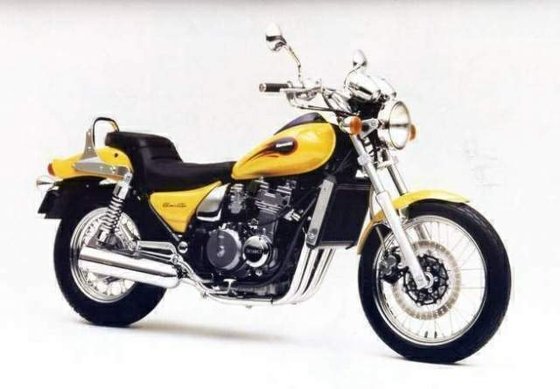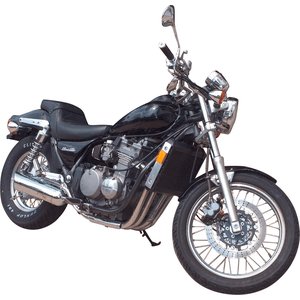Kawasaki ZL 600 Eliminator [1995-1998]: A Retrospective Review of the Underdog Cruiser

Introduction
The Kawasaki ZL 600 Eliminator (1995-1998) occupies a unique niche in motorcycling history. Born in an era when cruisers were defined by rumbling V-twins and laid-back ergonomics, this liquid-cooled inline-four machine dared to zig where others zagged. With its sportbike-derived engine and unconventional cruiser styling, the Eliminator became a curiosity—a bike that defied easy categorization. But does this underdog deserve more credit than it gets? After spending time with this 90s oddity, here’s our take on its quirks, charms, and place in the pantheon of cruisers.
Design & Styling: A Fusion of Conflicting Identities
At first glance, the Eliminator’s design language screams “cruiser” with its pulled-back handlebars, teardrop fuel tank, and a seat height that practically hugs the pavement at 715 mm (28.1 inches). The long 1,550 mm (61-inch) wheelbase and raked-out front end amplify its stretched-out posture, while the 150/80-15 rear tire adds a muscular stance. But look closer, and contradictions emerge. The engine—a compact inline-four—lacks the visual heft of a V-twin, and the bodywork carries subtle hints of Kawasaki’s sportier DNA.
Color options like bold yellow and stealthy black leaned into its rebellious identity, though the overall aesthetic feels caught between café racer minimalism and cruiser swagger. The steel double-cradle frame and tubular swingarm are functional but lack the sculpted flair of competitors. Still, the low-slung profile makes it approachable for shorter riders, and the narrow 218 kg (480 lb) wet weight (with fluids) keeps it manageable at stops.
Engine Performance: The Sportbike Heart in a Cruiser Body
Powering the Eliminator is a 593cc DOHC inline-four, a derivative of Kawasaki’s sportier mills. On paper, the 61 HP (45 kW) at 10,500 RPM and 46 Nm (33.9 lb-ft) of torque at 7,800 RPM suggest spirited performance. Reality, however, is more nuanced.
Low-End Manners: Throttle response below 4,000 RPM is polite but unenthusiastic. The Keihin 30mm CV carburetors prioritize smoothness over urgency, making stoplight pullaways civilized but far from thrilling.
Mid-Range Surge: Things wake up around 6,000 RPM, where the engine’s sportbike roots begin to shine. The exhaust note transitions from a muted hum to a metallic growl, and acceleration becomes brisk enough for highway merges.
Top-End Bite: By 9,000 RPM, the Eliminator feels alive—but this is also where the party ends abruptly. The powerband’s narrow window demands frequent gear shifts, and the 6-speed transmission (a rarity among cruisers of the era) becomes a necessity rather than a luxury.
Vibration & Refinement: At cruising speeds, the engine remains surprisingly smooth for an inline-four. However, hard acceleration introduces high-frequency vibes through the bars and pegs—a reminder that this powerplant lacks the low-stress torque of a V-twin.
Fuel Efficiency: Averaging 5.47 L/100 km (43 mpg), the 12-liter (3.17-gallon) tank offers a 220 km (137-mile) range—adequate for weekend rides but limiting for long hauls.
Handling & Ride Quality: Better Than It Looks
Cruisers aren’t known for carving corners, but the Eliminator’s chassis delivers surprises. The 37mm Kayaba front forks and dual rear shocks (adjustable for preload and rebound) offer a plush ride over small bumps, though sharp impacts send jolts through the rigid frame. Ground clearance is limited, and the footpegs scrape early when pushed.
Straight-Line Stability: The long wheelbase and relaxed steering geometry make highway cruising effortless. Crosswinds barely faze the bike, and the shaft drive eliminates chain maintenance hassles.
Low-Speed Agility: Despite its size, the Eliminator feels shockingly nimble in urban settings. The low seat and narrow profile simplify U-turns, while the light clutch pull reduces fatigue in traffic.
Braking Performance: Here’s where age shows. The single 280mm front disc with a twin-piston caliper lacks bite, and the rear drum brake is purely decorative. Modern aftermarket pads and braided lines (available at MOTOPARTS.store) would dramatically improve stopping power.
Comfort & Ergonomics: A Mixed Bag
The Eliminator’s riding position splits opinions. The ultra-low seat and pulled-back bars create a relaxed, feet-forward stance perfect for shorter riders. However, taller riders (over 180 cm / 5’11”) will feel cramped, with knees angled sharply upward.
Seat & Suspension: The thinly padded seat becomes punitive after an hour, and the short-travel rear suspension struggles with rough roads. Upgrading to a gel seat and premium shocks could transform comfort.
Wind Protection: The minimalist design offers zero wind deflection. At speeds above 110 km/h (68 mph), riders cling to the bars like shipwreck survivors.
Competition: How Does It Stack Up?
The mid-90s cruiser market pitted the Eliminator against formidable foes:
- Honda Shadow VLX 600:
- Pros: Torquey V-twin, bulletproof reliability, lower maintenance.
- Cons: Heavier, less agile, 5-speed transmission.
-
Verdict: The Shadow’s low-end grunt suits traditionalists, but the Eliminator’s rev-happy engine appeals to sportier riders.
-
Suzuki Intruder VS800:
- Pros: Larger 805cc V-twin, iconic styling, superior low-RPM power.
- Cons: Heavier, pricier, carburetion quirks.
-
Verdict: The Intruder dominates in raw muscle, but the Eliminator’s lighter weight aids maneuverability.
-
Yamaha Virago 535:
- Pros: Lighter, cheaper, easier customization.
- Cons: Anemic power, dated design.
- Verdict: The Eliminator’s inline-four offers a fresher personality for riders bored of V-twins.
Key Takeaway: The ZL 600’s uniqueness is both its strength and weakness. It won’t out-drag rivals, but its sporty engine character and nimble handling carve a distinct niche.
Maintenance: Keeping the 90s Icon Alive
Owners praise the Eliminator’s reliability, but aging examples demand attention to these areas:
- Valve Adjustments:
- Intake: 0.13–0.18 mm (0.005–0.007 in)
- Exhaust: 0.18–0.23 mm (0.007–0.009 in)
-
Frequency: Every 6,000 km (3,700 miles). Use quality feeler gauges for precision.
-
Oil Changes:
-
Capacity: 3.0L (3.2 qt) with filter. Opt for synthetic 10W-40 for better heat management.
-
Shaft Drive Care:
-
Fluid: 190ml SAE 80W GL-5. Replace every 24,000 km (15,000 miles).
-
Brake Upgrades:
-
Swap stock pads for sintered variants and retrofit braided stainless lines for firmer lever feel.
-
Tire Recommendations:
- The stock Bridgestone Exedras are outdated. Modern options like Michelin Commander IIIs improve grip and longevity.
Pro Tip: The liquid-cooled engine runs hotter than air-cooled cruisers. Regularly check coolant levels (2.0L capacity) and flush every two years.
Conclusion: A Quirky Contender Worth Rediscovering
The Kawasaki ZL 600 Eliminator isn’t perfect. Its engine lacks low-end punch, the suspension is basic, and the brakes belong in a museum. Yet, there’s charm in its refusal to conform. The inline-four’s eager revs, the flickable chassis, and the standout styling (for better or worse) make it a fascinating artifact of 90s experimentation.
For owners, MOTOPARTS.store offers upgrades to address its flaws—better brakes, suspension kits, and ergonomic tweaks. For riders seeking a cruiser that dares to be different, the Eliminator remains a conversation-starting alternative to the V-twin hegemony.
Ready to personalize your Eliminator? Explore our curated selection of performance parts, accessories, and maintenance kits at MOTOPARTS.store.
Specifications sheet
| Engine | |
|---|---|
| Stroke: | Four-stroke |
| Max power: | 45 kW | 60.0 hp |
| Max torque: | 46 Nm |
| Fuel system: | 4x Keihin CV 30 mm carburetors |
| Max power @: | 10500 rpm |
| Displacement: | 593 ccm |
| Fuel control: | DOHC |
| Max torque @: | 7800 rpm |
| Bore x Stroke: | 60.0 x 52.4 mm (2.4 x 2.1 in) |
| Configuration: | Inline |
| Cooling system: | Liquid |
| Compression ratio: | 11.0:1 |
| Number of cylinders: | 4 |
| Dimensions | |
|---|---|
| Wheelbase: | 1550 mm (61.0 in) |
| Dry weight: | 200 |
| Wet weight: | 209 |
| Seat height: | 715 mm (28.1 in) |
| Overall width: | 720 mm (28.3 in) |
| Overall height: | 1090 mm (42.9 in) |
| Overall length: | 2230 mm (87.8 in) |
| Fuel tank capacity: | 13 L (3.4 US gal) |
| Drivetrain | |
|---|---|
| Final drive: | shaft |
| Transmission: | 6-speed |
| Maintenance | |
|---|---|
| Rear tire: | 150/80-15 |
| Engine oil: | 10W40 |
| Front tire: | 100/90-18 |
| Break fluid: | DOT 4 |
| Spark plugs: | NGK DR9EA or NGK DR9EIX |
| Spark plug gap: | 0.7 |
| Coolant capacity: | 2.0 |
| Forks oil capacity: | 0.616 |
| Engine oil capacity: | 3.0 |
| Final drive oil capacity: | 190 ml SAE 80W GL-5 |
| Engine oil change interval: | Every 5000 km or 2 years |
| Valve clearance (intake, cold): | 0.13–0.18 mm |
| Valve clearance check interval: | 24,000 km / 15,000 mi |
| Valve clearance (exhaust, cold): | 0.18–0.23 mm |
| Recommended tire pressure (rear): | 2.5 bar (36 psi) |
| Recommended tire pressure (front): | 2.5 bar (36 psi) |
| Performance | |
|---|---|
| ¼ mile: | 12.2 seconds @ 171.9 km/h (106.7 mph) |
| Top speed: | 182 km/h (113 mph) |
| 0-100 km/h: | 3.83 seconds |
| Fuel consumption: | 5.47 L/100 km (43 mpg) |
| Chassis and Suspension | |
|---|---|
| Frame: | Tubular double cradle, steel |
| Rear brakes: | Drum |
| Front brakes: | Single 280 mm disc, 2-piston caliper |
| Rear suspension: | Dual shocks adjustable for rebound and preload damping |
| Front suspension: | 37mm Kayaba air-assisted telescopic fork |
| Rear wheel travel: | 89 mm (3.5 in) |
| Front wheel travel: | 137 mm (5.4 in) |



















